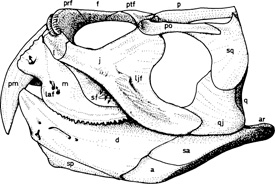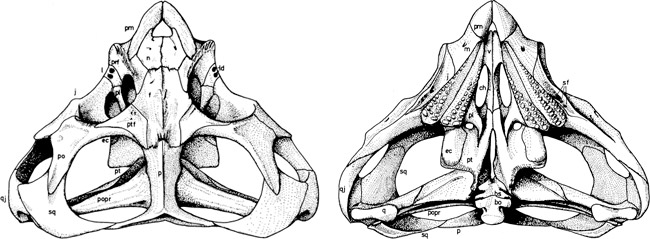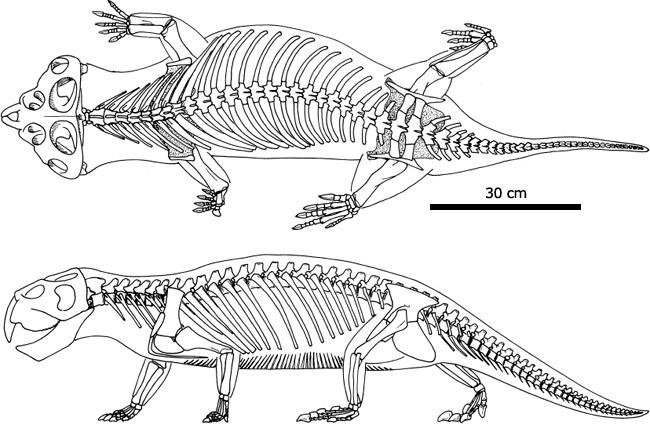
Rhynchosauria
Parrot-beaked reptiles
 Lateral view of the skull of the parrot-beaked Hyperodapedon. |
The earliest rhynchosaurs were small, less than a meter long, and had narrow, wedge-shaped skulls and a few small, blunt teeth for eating plants. Some other early archosauromorphs, such as trilophosaurs, were also herbivorous. It is not clear whether rhynchosaurs were closely related to these other herbivores or not. In some studies, rhynchosaurs are found to be close relatives of choristoderes, which were mostly aquatic predators.
Later rhynchosaurs, like Hyperodapedon, were up to two meters long and had very wide skulls and large beaks. Their skulls were much wider than they were long or tall, which gave them a hammer-head appearance (although the eyes were set close together near the top of the beak). The wide skulls have room for very large, powerful jaw muscles. The lower jaw fitted into a groove on the upper jaw, a mechanism that Benton (2005) described as being like the blade of a pocketknife closing into its handle.
 Dorsal and ventral views of the skull of Hyperodapedon. |
Rhynchosaurs had very odd teeth. Most reptiles have a single row of teeth in each jaw. They replace their teeth over and over again as they wear out, and the number of teeth in each jaw stays about the same over the animal's lifetime. None of those generalities apply to rhynchosaurs. Rhynchosaurs had many rows of small teeth closely packed together in the upper and lower jaws, like kernels of corn on a cob. These plate-like arrays of teeth formed surfaces for cutting and crushing plant material. The individual teeth were tiny, but they were firmly anchored to the jaw with very dense bone. This ankylothecodont (thick tooth socket) tooth attachment is unique to rhynchosaurs. Also, rhynchosaurs did not shed their teeth like other reptiles. Once their teeth were worn away, food was cut and ground against the dense bone of the jaws themselves. Finally, rhynchosaurs are unusual among vertebrates in that new teeth were added at the back of the jaws as long as the animal was growing.
Rhynchosaurs had large claws on their hind feet. These claws resemble the claws of digging animals, and rhynchosaurs may have used them for digging up roots and tubers. However, most diggers have the largest claws on their front feet, so if rhynchosaurs were diggers they were certainly unusual ones.
 Dorsal and lateral reconstructions of the skeleton of Hyperodapedon. |
Rhynchosaurs first appeared in the Lower Triassic. Rhynchosaur fossils have been found in North and South America, Europe, Africa, Madagascar, and India. They appear to have been relatively rare in North America, but in other parts of the world they were very abundant. Along with dicynodonts and aetosaurs, rhynchosaurs were important terrestrial herbivores before the rise of prosauropods and ornithischian dinosaurs near the end of the Triassic Period. The last rhynchosaurs went extinct just before the end of the Triassic, along with many other vertebrates. The cause of this extinction is unknown.
Sources
|
||
Text by Matt Wedel, 5/2007. Hyperodapedon images used with permission of the Royal Society of London: from Benton, M.J. 1983. The Triassic reptile Hyperodapedon from Elgin: Functional morphology and relationships. Philosophical Transactions of the Royal Society of London, B 302:605-717.